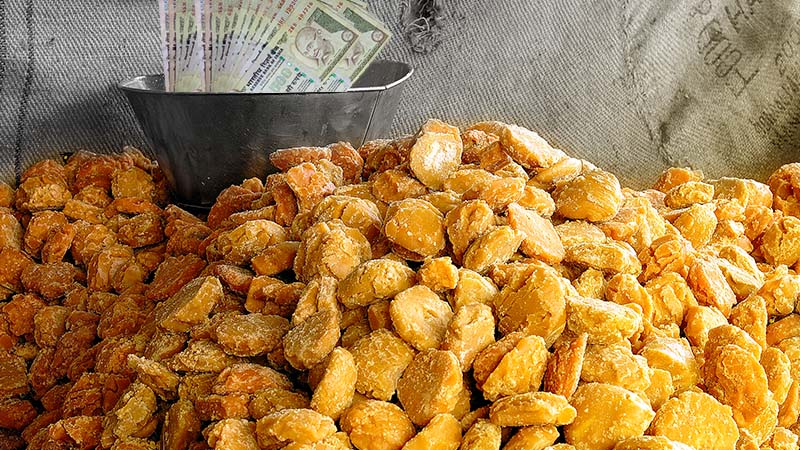Jaggery, popularly known as gur, is a golden-yellow to dark brown, coarse in texture, wholesome, traditionally used and unrefined sugar, obtained by concentrating sugarcane juice. It is produced almost in 25 countries under different names with a total production of 13 million tonnes per year. India is the largest producer of jaggery under unorganised agro-processing sector, sharing 55 per cent of the total world production, followed by Colombia (11 per cent).
In 2016, about 14.2 per cent of the total sugarcane produced in India is being utilised for making jaggery and khandsari (a mixture of crystalline sugar and molasses). In India, Uttar Pradesh is the major producer of sugarcane and jaggery, followed by Tamil Nadu.
The usefulness of jaggery has been recognised at the international level. Of the total world production, more than 60 per cent of the jaggery is being produced in India. As the major producer of jaggery, the country is recognised as one of the leading traders and exporters in the world. India exported 2,92,212 tonnes of jaggery and confectionery products worth Rs 1,289.2 crore in 2015-16. Major export destinations during this period were Nigeria, Kenya, the United Arab Emirates, Nepal and Myanmar, according to a report in The Indian Farming.
The jaggery industry has been one of the most ancient and important rural-based cottage industries in our country. It provides jobs to unemployed rural people in their vicinity with minimum capital investment. It also has high medicinal and nutritional values and easily available to rural people. Also, it may not be possible for sugar factories alone to meet total demand of sweeteners with increase of the population. It is, therefore, essential to safeguard the interest of jaggery manufacturing unit and improve and modernise the activities for more purposeful ends.
 Development and modernisation of jaggery sector need support in terms of statutory provisions and execution of a clear-cut plan for setting up of its units in a group of sugarcane producing areas, quality control laboratory at the district level and liaison with mega stores for its marketing and supply to consumers.
Development and modernisation of jaggery sector need support in terms of statutory provisions and execution of a clear-cut plan for setting up of its units in a group of sugarcane producing areas, quality control laboratory at the district level and liaison with mega stores for its marketing and supply to consumers.
It is consumed directly or used for preparation of sweet confectionery items and traditional (ayurvedic) medicines. The micro-nutrients present in jaggery possess anti-toxic and anti-carcinogenic properties. Magnesium in jaggery strengthens the nervous system, and potassium maintains the acid balance in cells. Jaggery is rich in iron and helps prevent anaemia in women. Its intake in the diet can prevent the atmospheric pollution related toxicity and may have a role to reduce the chance of lung cancer.
Traditionally referred as sugarcane jaggery, it is prepared from sugarcane juice. Besides sugarcane juice, jaggery is being made from other sources, like sap collected from different palm trees. All these jaggery types have their own characteristic taste and aroma. While, 60 to 70 per cent of the total jaggery comes from sugarcane, about 30 per cent comes from palm.
Jaggery is available in the market mainly in three forms, namely solid jaggery, liquid jaggery and granular jaggery. Of the total production of jaggery in India, approximately 80 per cent is prepared in solid form and 20 per cent is prepared in liquid as well as granular form. Liquid jaggery is a part of diet in most parts of Maharashtra and is gaining commercial importance. The liquid jaggery is being utilised as sweetening agent in foods and drinks in Maharashtra, Gujarat, Kerala, Andhra Pradesh and Tamil Nadu.
The preparation of quality jaggery is mainly affected by cultivation practices of sugarcane and its manufacturing process. The selection of cane variety, soil conditions, time of planting, fertiliser application, time of irrigation, crop protection from pest and diseases, harvesting of cane and post–harvest care of cane. Identified sugarcane varieties with high sucrose content are to be selected to prepare quality jaggery. Well-drained and salt-free loamy soils are well suited for sugarcane production to obtain quality jaggery. It is preferable to plant the crop between January and March and harvest it at its peak maturity. The inferior quality of jaggery is obtained due to delay in planting and crushing of immature or over-matured cane. All fertilizers (N, P, K) should be applied as per recommendation.
The excessive use of nitrogen reduces both quality and quantity of jaggery. Dead canes, water shoots, spoiled and rat infested canes should be discarded before crushing to prepare quality jaggery. Care must be taken to harvest the cane at the base of the clump as bottom portion of the cane is rich in sucrose. Cane should be crushed immediately after harvesting for extracting juice. Afterwards, there is reduction in cane weight (5-8 per cent) and juice (2 per cent).
The sugarcane juice is an opaque liquid and varies in colour from grey to dark green to light yellow depending upon the colour of cane. In addition to various nutritional constituents, it also contain mud, wax and several other soluble and insoluble impurities. To maintain proper quality in jaggery, all these soluble and insoluble undesirable fractions should be removed. However, manufacturing process depends on ultimate form to be produced. The minute detail of process varies widely from state-to-state.
In general, jaggery quality, storability and its acceptability depend on clarity of juice used in preparation. The juice collected from settling tank is further clarified during the boiling stage. It is mostly done by using lime — calcium hydroxide — addition. This lime addition simultaneously increases the normal pH of juice from 5.2 to 5.4 (which depend on harvesting status, variety of cane and soil condition) to around 6.0 to 6.4.
Addition of lime also improves the consistency of jaggery by increased crystallisation of sucrose, but at the same time it darkens the colour if added in excess. One kilogramme of lime (with purity of 80 to 90 per cent) is mixed with four litres of water, and about 60 to 70 millilitres of the resulting solution, milk of lime is proportionate to every 100 kilogrammes of cane juice.
Among other chemical clarificant, hydros is the next preferred by farmers. However, hydro being a bleaching agent has a decolourisation effect.
Addition of superphosphate, phosphoric acid, chemiflocks and alum are also reported. Use of these chemical clarificants is specific depending on the juice as they may function as bleaching agent, electrolyte or pH adjusting agent.
Problem of using chemical clarificants is that in most of the cases, limit of addition exceeds the permitted level. Vegetable clarificants like mucilage’s of bhendi, chikani, kateshevari, moranga leaf juice extract, lemon juice etc., were used in early period. But, because of being natural material, now-a-days emphasis are given on such type of clarificants. Boiling should be continued with removal of scum from time to time.
Cane juice continues to boiling until it becomes thick syrup with timely removal of scum. Small quantity of edible oils is added to prevent frothing during boiling after removal of entire scum. At the point, temperature plays a major role for moulding of this syrup into different forms of jaggery. The temperature at which cane juice slurry is modified into jaggery is known as striking point. The striking point varies from product to product.
After cane juice syrup attained desired striking point, jaggery charge is brought down from furnace, allowed for natural cooling for at least 15 to 20 minutes. After naturally cooling the jaggery, charge (consolidated syrup) is moulded into desired forms. After solidification, moisture content of solid jaggery reduces to 10 to 12 per cent.
Jaggery is prepared in different shapes and sizes in solid form in different parts of the India. Some of the common shapes are balls (250 grams to two kilogrammes), bucket-shaped lumps (10-20 kg), trapezoidal lumps (4-5 kg), rectangular blocks etc. Jaggery prepared in any forms gets deteriorated fast because of its high initial moisture content (10–12 per cent) and hygroscopic nature.
It is difficult to store jaggery during monsoon season, especially in coastal areas. The hygroscopic nature of jaggery is due to its non-sucrose constituents like glucose, fructose, proteins, etc which absorbs moisture from the atmosphere and run into liquid, thereby making the product unfit for consumption.
About one-third to half of the jaggery produced every year in country is stored for consumption during and after rainy season. About 5-10 per cent of jaggery stored is getting spoiled every year costing the nation a colossal loss.
The traditional lump form of jaggery is inconvenient for consumer to purchase for daily requirement. The lump is made into pieces according to consumer need, leading to loss of jaggery of about 10 per cent resulting in unhygienic environment.
Storage of jaggery varies from region to region, such as in earthen pots, wooden boxes and metal drums. Sometimes, without any container, heap of jaggery is just kept covered with cane trash, bagasse, wheat straw, cotton seed, furnace ash, palmyra leaf mat, rice husk, etc to protect the jaggery from ambient humidity.
In respect of the shape and size, jaggery deteriorates fast and become watery within three or four months because of presence of moisture, invert sugar and its hygroscopic nature. The hygroscopicity arises from non-sucrose constituents like glucose, fructose, protein etc. For good keeping quality, moisture content of jaggery should not exceed six per cent and it should be kept at a relative humidity of 43-61 per cent. It is very difficult to store jaggery in monsoon, especially in coastal areas of high rainfall and humidity. About 5-10 per cent of stored jaggery is spoiled every year, leading to a loss of 800 million. Cold storage godowns are being used in West Godavari and Visakhapatnam districts of Andhra Pradesh, Kolhapur district of Maharashtra and Muzaffarnagar area in Uttar Pradesh.
The inherent moisture content present in the traditional solid jaggery leads to development of microbes causing spoilage and limiting its shelf–life for a period of 3–4 months. The semi–solid jaggery mass is sheared into small granules.
Then, moisture content of granular jaggery is reduced to 1-2 per cent (db) by drying from initial moisture content of 10-12 per cent and packed in 400 gauge polythene sheet or polyethylene terephthalate bottles for safe storage.
(PTI)











